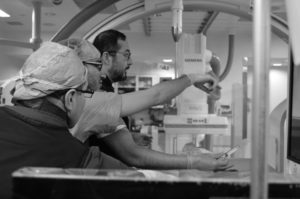November 2nd, 2016
Intracranial Aneurysms for the Non-Neurosurgical Provider: Primer Series (Part 2)
Bianca Belcher, MPH, PA-C
In Part 2 of this primer series on intracranial aneurysms for non-neurosurgical providers, I will discuss modifiable and non-modifiable patient risk factors for subarachnoid hemorrhage (SAH) during intracranial aneurysm treatment.
Modifiable Risks:
Hypertension (HTN)[1]
- Patients with mild-moderate HTN (defined by systolic blood pressure of 130-169 mmHg) have a hazard risk (HR) of 2.3 for SAH compared with patients with SBP <130.
- Patients with severe HTN (SBP >170 mmHg) have an HR of 3.3.
- The risk trend is similar for diastolic blood pressure.
Smoking[1]
- Former smokers have an HR of 2.7 compared with patients who have never smoked.
- Current smokers have an HR of 6.1 in the same comparison.
Cocaine Use[2]
- Cocaine use is associated with aneurysm risk in a younger population and in small vessels.
- Cocaine-related aneurysms have a higher mortality than others.
Non-modifiable Risks:
Age
- The incidence of SAH increases with age regardless of gender.[3]
Gender
- Females have an HR for rupture of 1.9 compared with males.[1]
Personal history of rupture
- As discussed in Part 1, history of SAH secondary to aneurysm rupture puts patients at a great risk of rupture (HR of 7.3 compared with no personal history of SAH).[4]
Genetic/Connective Tissue Disorders
- Autosomal dominant polycystic kidney disease
- Ehlers-Danlos Syndrome, Type IV (Vascular EDS)
- Marfan Syndrome
- Neurofibromatosis Type 1
- Pseudoxantoma Elasticum
- Loeys-Dietz Syndrome
- α1 –Antitrypsin Deficiency
Associated Conditions
- Fibromuscular Dysplasia (FMD)
- Arteriovenous Malformation
- Abdominal Aortic Aneurysm
- Sickle Cell Anemia
Family history of rupture
- In patients with polycystic kidney disease and at least one relative with aneurysms are 51 times more likely to have an aneurysm rupture compared with those who have no family history.[5]
Takeaways:
- We should counsel our patients heavily on the things that are within their control (the modifiable risks):
- Keep systolic blood pressure normotensive.
- Quit smoking if you are a current smoker or don’t start if you aren’t.
- Stay clear of cocaine.
- The non-modifiable risks are more useful to the provider — to help inform decision-making.
- You might consider screening patients for aneurysms if they have two primary relatives with known aneurysms (ruptured or unruptured) OR if they have one of the listed genetic conditions or associated conditions.
- Magnetic resonance angiogram (MRA) of the head is the preferred screening tool. Unlike computed tomography with angiography, MRA scans do not expose the patient to radiation and do not require a dye injection.
- Screening patients with some of the genetic disorders is controversial since their vessels tend to be more friable, making them more difficult and dangerous to treat.
The third and final part of this series will cover available treatment options for intracranial aneurysms.
Note: A special thanks to Dr. Thabele M. Leslie-Mazwi (neuroendovascular and neuro critical care specialist at Massachusetts General Hospital) for his help retrieving some of the studies used in this post.
References
- Sandvei, e.a., Risk Factors for Aneurysmal Subarachnoid Hemorrhage in a Prospective Population Study: The HUNT Study in Norway. Stroke, 2009. 40: p. 1958-1962.
- Nanda, A., et al, Intracranial Aneurysms and Cocaine Abuse: Analysis of Prognostic Indicators. Neurosurgery, 2000. 46(5): p. 1063-1069.
- N K de Rooij, e.a., Incidence of subarachnoid haemorrhage: a systematic review with emphasis on region, age, gender and time trends. J Neurol Neurosurg Psychiatry, 2007. 78: p. 1365-1372.
- Ishibashi, e.a., Unruptured Intracranial Aneurysms Incidence of Rupture and Risk Factors. Stroke, 2009. 40: p. 313-316.
- Irazabal, e.a., Extended Follow-Up of Unruptured Intracranial Aneurysms Detected by Presymptomatic Screening in Patients with Autosomal Dominant Polycystic Kidney Disease. Clin J Am Soc Nephrol, 2011. 6: p. 1274-1285.




Does size of vessel matter? What is rate of idiopathic disease?